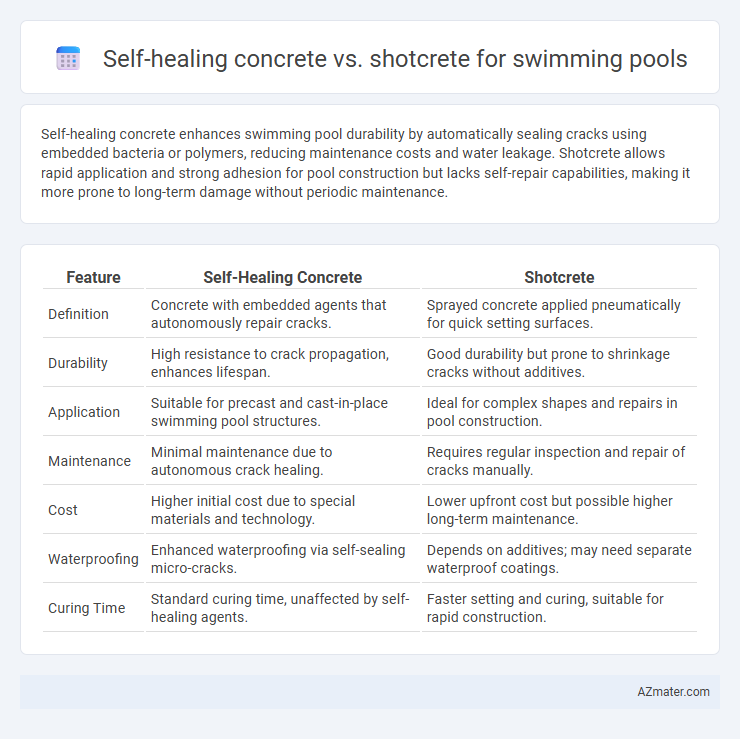Self-healing concrete enhances swimming pool durability by automatically sealing cracks using embedded bacteria or polymers, reducing maintenance costs and water leakage. Shotcrete allows rapid application and strong adhesion for pool construction but lacks self-repair capabilities, making it more prone to long-term damage without periodic maintenance.
Table of Comparison
| Feature | Self-Healing Concrete | Shotcrete |
|---|---|---|
| Definition | Concrete with embedded agents that autonomously repair cracks. | Sprayed concrete applied pneumatically for quick setting surfaces. |
| Durability | High resistance to crack propagation, enhances lifespan. | Good durability but prone to shrinkage cracks without additives. |
| Application | Suitable for precast and cast-in-place swimming pool structures. | Ideal for complex shapes and repairs in pool construction. |
| Maintenance | Minimal maintenance due to autonomous crack healing. | Requires regular inspection and repair of cracks manually. |
| Cost | Higher initial cost due to special materials and technology. | Lower upfront cost but possible higher long-term maintenance. |
| Waterproofing | Enhanced waterproofing via self-sealing micro-cracks. | Depends on additives; may need separate waterproof coatings. |
| Curing Time | Standard curing time, unaffected by self-healing agents. | Faster setting and curing, suitable for rapid construction. |
Introduction to Innovative Pool Construction Methods
Self-healing concrete incorporates microcapsules or bacteria that activate upon cracking, enabling autonomous repair and significantly extending swimming pool durability. Shotcrete, a sprayed concrete method, offers rapid application and superior adhesion to complex pool shapes, ensuring structural integrity and design flexibility. Both advanced materials revolutionize pool construction by enhancing strength, reducing maintenance, and optimizing long-term performance.
Understanding Self-Healing Concrete
Self-healing concrete incorporates bacteria or chemical agents that activate upon water ingress, sealing cracks automatically to enhance durability and reduce maintenance in swimming pools. Unlike shotcrete, which is traditionally sprayed concrete applied in layers for structural support, self-healing concrete actively repairs micro-cracks, preventing leaks and extending pool lifespan. Its innovative properties provide long-term waterproofing benefits and cost efficiency compared to conventional shotcrete applications.
Exploring Shotcrete Technology
Shotcrete technology offers a highly adaptable and durable solution for swimming pool construction, characterized by its pneumatically applied concrete that ensures strong adhesion to pool surfaces. Unlike traditional self-healing concrete, shotcrete allows for rapid application and sculpting, providing precise control over pool shape and thickness while delivering superior resistance to cracking. Its proven performance in waterproofing and structural integrity makes shotcrete a preferred choice for creating long-lasting and visually appealing swimming pools.
Key Differences Between Self-Healing Concrete and Shotcrete
Self-healing concrete incorporates microcapsules or bacteria that activate to repair cracks autonomously, enhancing durability and reducing maintenance for swimming pools. Shotcrete, a sprayed concrete method, offers rapid application and versatility over complex shapes but lacks intrinsic crack-repair capabilities. While shotcrete provides efficient structural formation and waterproofing, self-healing concrete delivers long-term resilience by mitigating crack propagation and water infiltration.
Durability and Longevity Comparison
Self-healing concrete enhances swimming pool durability by automatically repairing micro-cracks, significantly reducing maintenance needs and extending lifespan compared to traditional materials like shotcrete. Shotcrete offers high initial strength and quick application but is more prone to cracking and water infiltration over time, impacting longevity. The advanced microbe-based healing properties of self-healing concrete provide superior resistance to chemical degradation and freeze-thaw cycles, making it a more durable option for long-term swimming pool construction.
Water Resistance and Leak Prevention
Self-healing concrete enhances water resistance in swimming pools by utilizing microcapsules or bacteria that activate upon cracking, sealing leaks automatically and extending structural longevity. Shotcrete, while providing a dense and strong layer, relies heavily on skilled application and proper curing to prevent water penetration and leaks. For optimal leak prevention, self-healing concrete offers superior long-term performance by autonomously addressing microcracks that commonly compromise traditional shotcrete barriers.
Application Process and Installation Time
Self-healing concrete applied in swimming pools involves integrating microcapsules or bacteria that autonomously repair cracks, requiring standard pouring and curing similar to traditional concrete, which typically extends installation time due to curing periods of 28 days or more. Shotcrete, a pneumatically applied concrete sprayed onto surfaces, allows for faster installation as it requires no formwork and cures more quickly, often within 7 days, making it ideal for complex shapes and rapid construction. Choosing between self-healing concrete and shotcrete depends on prioritizing long-term durability with slower installation versus speed and flexibility in the application process.
Cost Analysis: Self-Healing Concrete vs Shotcrete
Self-healing concrete for swimming pools offers long-term cost savings by reducing maintenance and repair expenses due to its ability to autonomously heal cracks, whereas shotcrete typically requires more frequent upkeep and patching. Initial installation costs of self-healing concrete are higher compared to shotcrete, which is generally more affordable and faster to apply. Over time, the lifecycle cost analysis favors self-healing concrete, making it a cost-effective investment despite the upfront premium.
Maintenance Requirements and Sustainability
Self-healing concrete significantly reduces maintenance requirements in swimming pools by autonomously repairing cracks, thereby preventing water leakage and structural damage over time. Shotcrete, while providing a quick and versatile application, often demands more frequent inspections and repairs due to its susceptibility to cracking and environmental wear. In terms of sustainability, self-healing concrete enhances durability and lifecycle performance, decreasing resource consumption and waste from repairs, whereas shotcrete typically involves higher maintenance-related material use and environmental impact.
Choosing the Right Concrete Solution for Your Swimming Pool
Self-healing concrete offers innovative crack repair through embedded microcapsules or bacteria, significantly enhancing durability and reducing maintenance in swimming pools. Shotcrete provides rapid application and superior adherence, making it ideal for complex pool shapes and quick project turnaround. Choosing the right concrete depends on prioritizing longevity and minimal upkeep with self-healing technology or efficiency and structural flexibility with shotcrete.

Infographic: Self-healing concrete vs Shotcrete for Swimming pool
 azmater.com
azmater.com